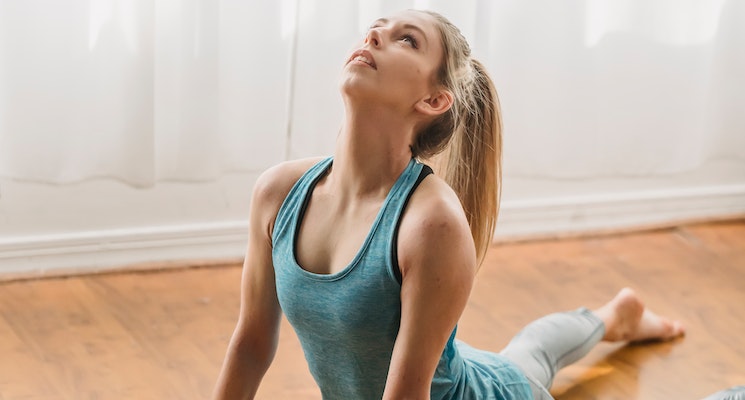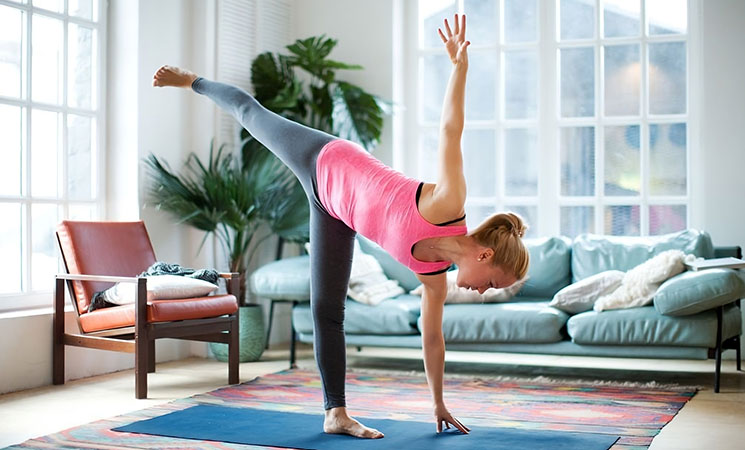Welcome to this blog post about Vinyasa yoga poses for beginners! If you’re just starting out in the world of yoga, Vinyasa is a wonderful style to explore.
This type of yoga focuses on linking movement with breath, creating a flowing sequence that helps to build strength, flexibility, and mindfulness. In this post, we’ll guide you through some of the foundational Vinyasa yoga poses that are perfect for beginners.
Whether you’re looking to increase your physical strength or reduce stress and anxiety, we hope these poses will provide you with the support and encouragement you need to continue your yoga journey. So find a comfortable spot, roll out your mat, and let’s get started with some Vinyasa yoga poses!
What is Vinyasa Yoga?
Vinyasa yoga, also known as flow yoga, is a popular contemporary style of yoga that involves smoothly transitioning from one pose to another using breath coordination.
In the previous sections, we learned about the importance of warming up with standing poses, the basic vinyasa flow sequence, and specific poses like downward-facing dog and upward facing dog. But what is vinyasa yoga, exactly?
The word vinyasa can be translated as arranging something in a special way, and in yoga, it refers to the linking of poses together to create a flowing sequence.
This style of yoga is characterized by its cyclical movements, smooth transitions, and emphasis on breath. In vinyasa yoga, the poses are not held for long periods of time, but rather, the focus is on the transition between the poses. Moving dynamically and continuously through the poses can help build strength, flexibility, and focus.
Importance of Warming up with Standing Poses
In vinyasa yoga, warming up with standing poses is crucial for beginners to prepare their bodies for the practice ahead. It helps in building strength, increasing flexibility, and enhancing body awareness. Standing poses like Tadasana or Mountain Pose are simple yet effective warm-up postures that help in grounding and centering the body.
These postures activate the quads, glutes, and core muscles, creating stability and balance in the body. Additionally, practicing standing poses at the beginning of a vinyasa flow can also help to calm the mind and focus the breath, making it easier to move through the practice with more fluidity and ease.
Overall, warming up with standing poses is an integral part of the vinyasa yoga practice and can contribute significantly to the overall benefits of the practice for beginners.
Basic Vinyasa Flow Sequence
Moving on to the basic vinyasa flow sequence, this is where the real yoga practice begins. As previously mentioned, vinyasa yoga is all about the sequence of poses flowing together, so the basic flow sequence typically involves transitioning from Downward-facing dog to Plank pose, lowering down to the ground, and moving into Cobra pose before transitioning back to Downward-facing dog.
Practicing this sequence repeatedly helps you build strength and flexibility while also improving your breathing and focus.
Remember to move slowly through each pose, paying attention to your bodys limitations and not pushing yourself too hard.
And if some poses are too challenging, dont be afraid to pause and rest or modify the pose until youre comfortable enough to move on to the next one.
With a little practice, the basic vinyasa flow sequence will become second nature and help you feel more centered and energized with each round.
Downward-facing Dog Pose (Adho Mukha Shvanasana)
The fourth section in the blog about vinyasa yoga for beginners is all about the ever-popular Downward-facing dog pose or Adho Mukha Shvanasana.
This foundational yoga pose is often the first pose you learn in yoga practice and is done multiple times in a vinyasa yoga class.
It requires flexibility and upper body strength and offers a full-body stretch, particularly in the shoulders, hamstrings, and hips. In this pose, one must press through their hands and lift the hips back and up to create an upside-down V shape.
Beginners may find it challenging, but proper warm-up of the calves and arms before performing the asana can help.
The Downward-facing dog pose is frequently used as a transition and resting pose, making it an excellent addition to any basic vinyasa flow sequence.

Moving slowly through each pose and pausing and resting when needed is crucial for beginners to enjoy the practice fully. Practicing vinyasa yoga with Downward-facing dog pose brings many benefits, including toning the entire body and strengthening core muscles.
Upward Facing Dog Pose
After warming up with standing poses, it’s time to move onto the more challenging postures, like Upward Facing Dog Pose.
This advanced backbend pose can be intimidating for beginners, but with proper alignment and guidance, it can be done safely and effectively.
From Table Pose, slowly drop the hips forward toward the floor, while pressing up actively from the palms and drawing the shoulders away from the ears.
This pose stretches and opens the chest, shoulders, and abdominal muscles, while also strengthening the back and arms. Remember to move slowly through each pose, taking time to pause and rest whenever needed.

As a beginner, it’s important to listen to your body and not push too hard too fast. Practicing Upward Facing Dog Pose as part of a vinyasa flow sequence can lead to numerous benefits, including improved posture, increased flexibility, and reduced stress levels.
Half-Moon Pose
Half-moon pose, also known as Ardha Chandrasana, is a challenging yet rewarding balance pose that builds core strength, improves balance, and enhances flexibility.
As discussed in the previous sections, warming up with standing poses is crucial before starting a vinyasa flow sequence. Downward-facing dog pose and upward-facing dog pose are essential postures in vinyasa yoga, laying the foundation for balancing poses like half-moon.
Moving slowly through each pose and pausing to rest during challenging poses are tips that beginners should keep in mind while practicing yoga.

Incorporating hands-free flows is advantageous for beginner yogis looking to gain confidence and strength while enjoying their practice. Finally, the benefits of practicing vinyasa yoga as a beginner include strengthening the whole body, improving focus and balance, enhancing core stability, and gaining confidence.
Half-moon pose is an excellent posture for achieving these benefits and building physical and mental strength, making it a vital part of any vinyasa yoga practice.
Tips for Moving Slowly Through Each Pose
Moving slowly through each pose in vinyasa yoga is an important aspect of the practice. As mentioned earlier, vinyasa yoga is all about flowing and connecting movements with breath.
Therefore, moving slowly and mindfully can help build strength and flexibility while also improving focus and concentration.
One tip for moving slowly through each pose is to pay attention to the transitions between poses. Keep the movements smooth and controlled, ensuring that the breath is integrated with each movement. Another tip is to focus on proper alignment and body positioning in each pose.
Taking the time to ensure that the body is align, can help prevent injuries and allow for greater benefits from the practice.
Remember to move at your own pace and don’t be afraid to take a break or rest when needed.
By practicing vinyasa yoga with a slow and steady approach, beginners can continue to develop their practice and see improvements both on and off the mat.
How to Pause and Rest During Challenging Poses
When practicing vinyasa yoga, it is important to remember that taking breaks and resting during challenging poses is completely acceptable.
In fact, it recommend to pause and rest when needed to avoid exhaustion or injury. During these moments of rest, yogis can focus on their breath and regain their strength before continuing with the flow sequence.
Beginners should not feel discouraged if they need to rest frequently during their practice, as it is a natural part of the process.
Through consistent practice, students will gradually build strength and endurance, allowing them to stay in challenging poses for longer periods of time.
It is important to listen to the body and rest when needed, rather than pushing through discomfort. By incorporating regular rest periods in their practice, beginners can prevent burnout and feel more confident in their yoga journey.
Hands-Free Flow for Beginner Yogis
For beginner yogis who may not be ready for hands-on poses, hands-free vinyasa flow can be an excellent option.
This style of yoga eliminates the need for hands-on adjustments and allows the practitioner to focus solely on breath and movement.
Poses such as seated twists, lunges, and gentle backbends can create a flow similar to traditional vinyasa yoga, without requiring any arm or hand support.
Practicing hands-free can also be a great way to build strength and flexibility in the lower half of the body, as well as improve balance and coordination.
With a little patience and persistence, beginners can master hands-free vinyasa flow and reap the many benefits of this popular yoga style.
Benefits of Practicing Vinyasa Yoga as a Beginner
Practicing vinyasa yoga poses as a beginner has numerous benefits. In addition to keeping you active, it reduces stress and increases flexibility.
By coordinating movement with breath, vinyasa yoga helps to calm the mind and find presence in the body. It’s also a great way to warm up with standing poses and improve overall balance.
As a beginner, it’s important to move slowly through each pose and remember to pause and rest during challenging ones.
Additionally, practicing vinyasa yoga without the use of hands can help build strength and improve alignment.
Overall, incorporating vinyasa yoga into your routine as a beginner can lead to better physical and mental health.











